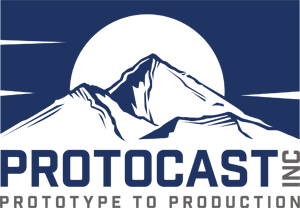What is expected tool life of sand cast tooling?
Approximately 500pcs. Dependent on geometry, proper draft, radii, etc.
What is expected tool life of permanent mold tooling?
Approximately 40,000 shots before refurbishment.
What are typical tolerances I can expect with sand casting?
We follow the Aluminum Association Standards for Aluminum Sand and Permanent Mold Castings.
What are typical tolerances I can expect with permanent mold casting?
We follow the Aluminum Association Standards for Aluminum Sand and Permanent Mold Castings.
What is the typical surface finish for sand casting?
Typically, 350-450 rms.
What is the typical surface finish for permanent mold casting?
Typically, 125-250 rms.
Where is your work performed?
Most every service we offer is performed under our roof in Commerce City, CO.
Do you pour steel or iron castings?
No. Protocast is a non-ferrous foundry that focuses on aluminum, magnesium, and zinc cast and machined parts.
What is the minimum wall thickness for sand castings?
Typically, 0.160”, but exceptions are possible. This is contingent on geometry.
What is the minimum wall thickness for permanent mold castings?
Typically, 0.125”, but exceptions are possible. This is contingent on geometry.
Do you offer anodizing, chem film, or powder coating?
Yes, using local outside sources, we offer these finishing services.
Can Protocast provide chemical analysis and/or tensile testing?
Yes. In house spectrometer is available.
What are typical lead times for sand cast samples?
Typically 4-6 weeks for raw castings. Add 1-2 weeks for secondary machining. Contingent on part geometry, and current workload.
What are typical lead times for permanent mold cast samples?
Typically 10 weeks for raw castings. Add 1-2 weeks for secondary machining. Contingent on part geometry, and current workload.
Do you source your permanent mold tools overseas?
Typically we do not. However, we can if requested.
What is the difference between high pressure die casting and permanent mold or low pressure die casting?
The main difference is how the die is filled. Each process uses steel tooling. High pressure die casting uses higher pressure to push the alloy into the die. Permanent mold dies can be filled using gravity such as Tilt-Pour, or low pressure by pushing the alloy into the die from underneath.
Do you offer machining in house?
Yes. 3, 4, and 5 axis machining capabilities are all available.
Do you offer heat treating in house?
Yes. Protocast has one of the largest aluminum heat treating systems in the state of Colorado.
Can Protocast perform flow simulation for my casting?
Yes. Most parts are verified with our EKK flow simulation software at the quote level.
Can I get DFM feedback with my quote?
Yes, most quotes are returned with DFM feedback.


